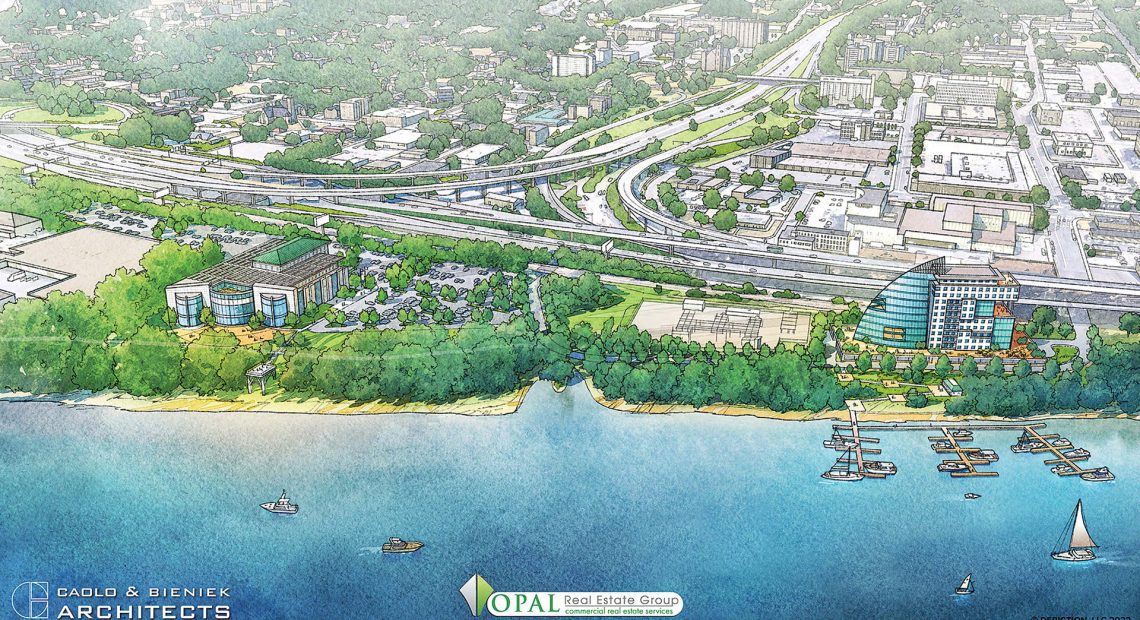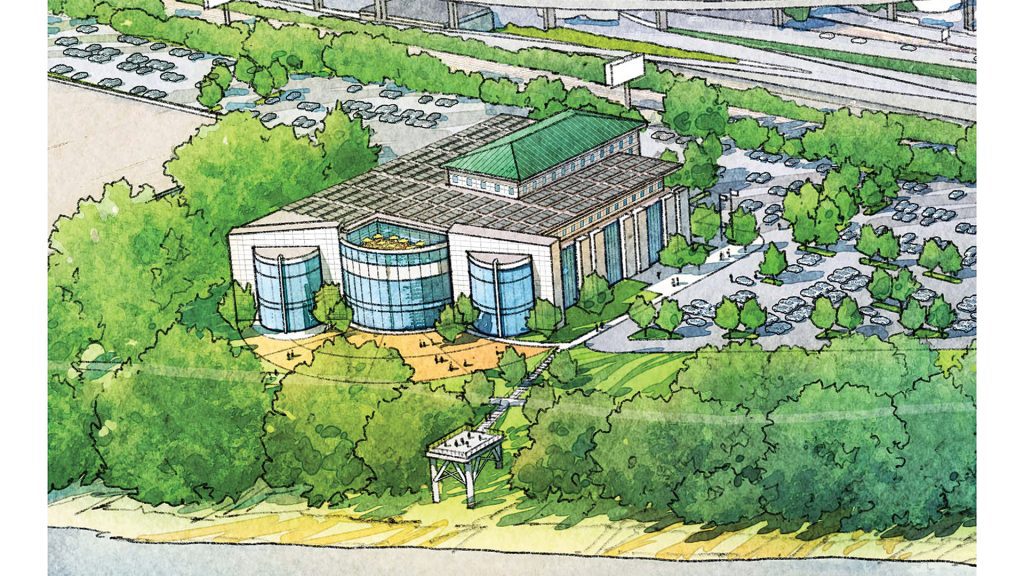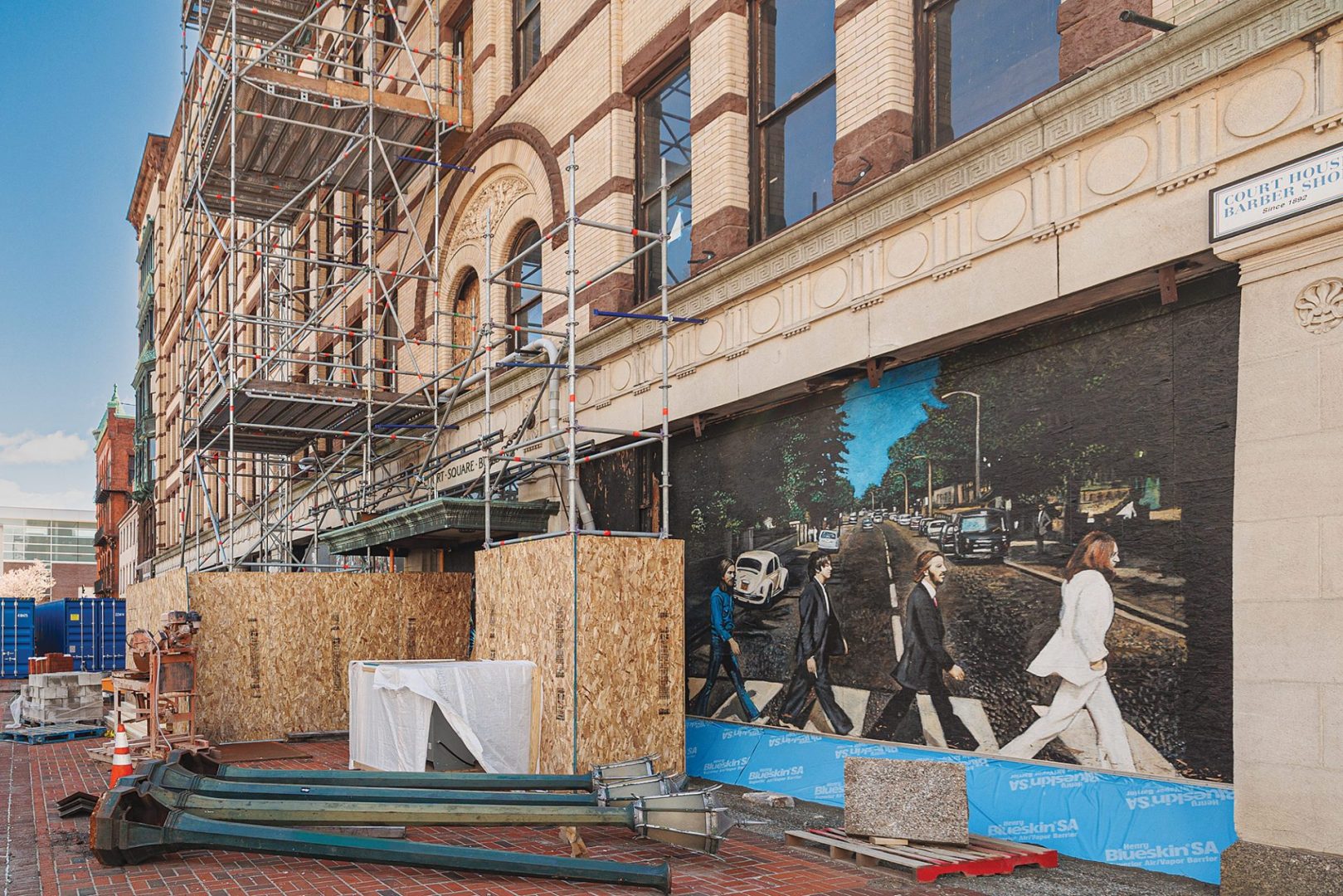
Peter Picknelly Blueprints Another Legacy Project
A Developing Story

An architect’s rendering of a proposed new courthouse, apartment complex, and marina for Springfield’s riverfront.
As he talked about the many real-estate development projects he’s been involved with over the years and how they’ve come to the drawing board and then off it, Peter Picknelly said simply, “they develop … and then they happen.”
That was a very simple explanation for what is often a very complex process, especially with some of the projects he and his team at the OPAL Real Estate Group have taken on over the years, many of which have involved public-private partnerships and have taken years, if not decades, to become reality.
What he meant was that each project starts with a concept, or a vision — the marriage of a location or an existing building with a new use, or uses, often with higher goals, such as sparking additional development in a given area or neighborhood, or bringing new life to dormant, sometimes historic properties.
This has been the case with many projects in the OPAL portfolio — from the transportation and education center in downtown Holyoke to the conversion of the former Clarke School for the Deaf in Northampton into luxury apartments, to a similar but much more complicated effort to transform the former Court Square Hotel in downtown Springfield into market-rate housing.

Peter Picknelly says Springfield’s riverfront, and especially the stretch north of the Memorial Bridge, is an untapped resource and the ideal location for a new courthouse.
And this is the same general formula being applied to the most ambitious project yet undertaken by Picknelly and his team at OPAL Real Estate — the transformation of land on Springfield’s riverfront, north of the Memorial Bridge, into a home for a new Hampden County courthouse and, perhaps, an apartment complex and marina, a concept that comes with a price tag just under $500 million.
the most ambitious project yet undertaken by Picknelly and his team at OPAL Real Estate — the transformation of land on Springfield’s riverfront, north of the Memorial Bridge, into a home for a new Hampden County courthouse and, perhaps, an apartment complex and marina, a concept that comes with a price tag just under $500 million.
Plans for this concept were unveiled at an elaborate press conference last month, with Picknelly and others, including Springfield Mayor Domenic Sarno and Chief Development Officer Tim Sheehan, touting the proposed project as a potential economic catalyst for both the riverfront and Springfield’s North End.
And as a solution to what has become a huge health hazard in Springfield — the Roderick L. Ireland Courthouse, which has been beset with problems ranging from mold and ventilation issues to alarming reports of employees getting sick and in some cases dying of cancers and other diseases linked to environmental concerns.
Indeed, a recent report by the state Trial Court’s Environmental Advisory Committee, made up of courthouse employees, said the courthouse is linked to more than 50 cancer diagnoses and five employees who have died of ALS.
Headlines announcing these reports and the state’s ongoing efforts to clean and perhaps renovate a building that people don’t want to go in — the Hampden Registry of Deeds and the district attorney’s office have relocated staff out of the building — prompted those at OPAL to create that vision that was announced last month, said Picknelly.
“It’s pretty clear to me that there is something wrong, very wrong, with that building,” he said. “There are 25,000 people who have been diagnosed with ALS; five have died in one building! That’s an amazing number. And 60 people have some form of cancer? We need a new courthouse, and anyone who cares about Springfield would have that on their radar.”
But there are very few spots in the city that can accommodate a new courthouse. Picknelly says he has one — or can assemble one.
The land in question has been considered for everything from a casino to a site for a UMass Springfield campus to the possible home for a minor-league baseball stadium. But it remains undeveloped and needs a spark to become a real asset for the city.
The proposed courthouse, a true public-private endeavor, could become that spark, he said, adding that this project, if it comes to fruition — and there are many hurdles to clear, as we’ll see — could lead to additional development along the riverfront and in the North End.

“I think this is an exciting opportunity for our city to expand its downtown area and open up the river, finally, for all sorts of activities,” said Picknelly, who called the Court Square initiative a ‘legacy project,’ and believes the same term could be applied to the courthouse endeavor. “We’ve always thought that our land on the riverfront was underutilized, and that, at some point, it should be developed, and this seemed like a great opportunity, so we’re running with it, and we think it has some legs.”
For this issue, BusinessWest looks at Picknelly’s impressive development track record and how this latest project would become an intriguing next chapter.
Right Place, Right Time
Picknelly said OPAL is an acronym, with those letters starting the names of his four children — Olivia, Peter, Alyssa, and Lauryn.
Over the years, it has become synonymous with large-scale, often difficult projects that often involve public-private partnerships. The Picknelly Adult and Family Education Center on Maple Street in Holyoke, which houses bus services on the ground floor and Holyoke Community College’s Adult Learning Center on the upper floors, is one example, while the Court Square project, which boasts an array of partners, including the state, MGM Springfield, Winn Development, and OPAL itself, is another.
“I think this is an exciting opportunity for our city to expand its downtown area and open up the river, finally, for all sorts of activities. We’ve always thought that our land on the riverfront was underutilized, and that, at some point, it should be developed, and this seemed like a great opportunity, so we’re running with it, and we think it has some legs.”
Picknelly said that he and his team at OPAL look for development opportunities across the region, often responding to requests for proposals for specific buildings and properties, as in Holyoke and Court Square, but often by being proactive, sometimes with property owned by Picknelly or Peter Pan.
Such is the case with the existing Hampden County courthouse and the need to find a solution to the ongoing health problems there.
Picknelly and his team at OPAL first became involved with the goal of perhaps finding a temporary home for the courthouse to be used while the existing property is cleaned and renovated. But amid the headlines about illness and death and the high costs of making the building safe, the thought process shifted to finding a permanent solution in the form of a new home.
“The more you looked into it, the worse it got,” he said. “So we asked, ‘where can you build a new one and keep it in the downtown area?’ Because this is important to Springfield.”
The solution that presented itself is the 14.5-acre parcel on the riverfront owned by Picknelly — as well as an adjoining parcel owned by the Republican Co., which is the planned location of the new courthouse; Picknelly is seeking to purchase that parcel.
The land owned by Picknelly is currently home to Peter Pan’s Coachbuilders repair and maintenance facility as well as a number of billboards, which are generating some revenue from lease deals.
As noted earlier, it has been considered for several different uses, including a baseball park — several different proposals for such a facility have been forwarded over the years. And Picknelly said UMass Amherst considered the site before it eventually located its downtown Springfield campus in Tower Square. It then became part of the parcel pieced together for a proposed Western Mass. casino, which was eventually built in the South End.
While the site has remained mostly idle, it has always had vast potential to bring life and business not only to an attractive stretch of the riverfront, but to the North End of the city, which has Union Station, but has long needed a catalyst that can attract different kinds of development.
A new courthouse could be that catalyst, said Picknelly, adding that, while such facilities are generally not thought of as economic development, they are worthy of that description, and for many reasons.
Start with the number 1,600. That’s how many people typically visit the Roderick L. Ireland Courthouse on a daily basis — or would visit it if they were not afraid to venture inside, said Picknelly, adding that this kind of visitation, which includes those with business in the courts, court employees, jurors, and lawyers, could spawn different types of development, from restaurants to office buildings housing lawyers who want to be close to the courthouse.
“Your development is literally right on the water. Nowhere else in Springfield’s downtown can you have that.”
“I don’t think people realize how much activity a courthouse brings to a community,” he said. “It’s an economic-development driver.”
Ultimately, Picknelly believes the courthouse and apartment complex can do for the riverfront north of Memorial Bridge what the Basketball Hall of Fame complex has done for the area south of the bridge — in short, make it a destination.
“Before the Hall of Fame, there was essentially nothing there,” he said, referring to the collection of industrial properties that stood where the Hall is now. “Now, you have restaurants and vibrancy … the courthouse can do the same for the north side of the riverfront.”
It could potentially do even more, he went on, because on the south side of the bridge operating railroad tracks stand between the Hall of Fame and other businesses and the river itself. That problem doesn’t exist on the north side.
“Your development is literally right on the water,” he noted. “Nowhere else in Springfield’s downtown can you have that.”
While the proposed site — and the project envisioned for it — makes sense on many levels, said Picknelly, a number of pieces need to fall into place, especially at the state level.
Courting Opportunity
At present, the state and its Division of Capital Asset Management (DCAM) is still weighing whether to renovate the existing courthouse or move into a new one; a deep cleaning of the facility is currently underway.
Sarno and Picknelly have both questioned the wisdom of investing what could be hundreds of millions of dollars in a building that has reportedly been linked to serious illness and death.
“We think cleaning it is great, but ultimately, a new courthouse is needed in Springfield,” said Picknelly, adding that there are several options moving forward for the project and this parcel, with the best, in his view, being the property developed by OPAL and then leased by the state.
“It would be much faster if that was the chosen route,” he told BusinessWest. “Just the procurement process for securing the land would take two years; we can have shovels in the ground quickly. Ultimately, we believe the project can be done, start to finish, in four years.
“Right now, they’re talking about cleaning the building and renovating the current building — that will take seven years and probably cost $200 million when you factor in the cleaning of the facility and what they would have to do to move to the courts to a temporary facility for several years. That’s 70% of building new, and even if you do clean it, people are going to be very reluctant to go into it.”

OPAL Real Estate has become part of a number of ambitious public-private development initiatives, including the ongoing work to transform the former Court Square Hotel into market-rate housing.
Photo by Joe Santa Maria, Kill the Ball Media
Picknelly noted an additional benefit to building new is that Springfield gains an additional development site — the current courthouse location, in the heart of downtown and across State Street from the MGM casino complex.
If the courthouse moves to the riverfront, you then have that property to be developed for some other activity,” he said. “There are all sorts of opportunities; it’s great land that could be developed for other public purposes.”
When asked to give a timeline for the courthouse project, Picknelly said there are many factors that will play into if it happens and when it happens, from whether the current administration wants to address this problem or pass it on the next one, to how quickly DCAM can study and then weigh the costs and benefits of building new versus renovating what currently exists.
But he expects something — he’s not sure what — to happen within the next year, because of the severity of the health concerns in the current courthouse and the need to find a solution.
Much of his development activity over the past few decades falls into that category of ‘finding solutions,’ and this would certainly be another legacy project for the portfolio.
It is a developing story — figuratively, but also quite literally.
George O’Brien can be reached at [email protected]




